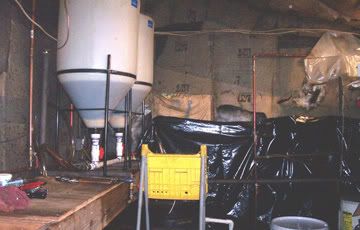Backyard Bio-Diesel Processing Hazards

Executive Summary: Homemade bio diesel production requires other hazardous materials for the processing. Some of these chemicals include sodium hydroxide, ethanol or methanol. What used to be a residential garage fire can escalate into a miniature fuel storage facility. Has anyone responded to an incident involving one of these newly forming facilities? With new technology comes new hazards...
Bio Diesel Home Processing: As fuel prices continue to rise, more and more backyard inventors will tinker with ideas to discover low-cost alternatives to gasoline and petroleum-based diesel. This also means that any of us has the potential to respond to a structure fire and find this type of "home processing". It also means that an engine company may be responding to a hazardous materials incident... and I doubt you will see a NFPA 704 Hazardous Materials Placard on the garage door...
One product that has some market potential is “biodiesel,” a motor vehicle fuel created from one or more organic products such as soy, corn, grasses, or animal fats. The home operation in the photograph used recycled cooking oil from a fast food restaurant to make biodiesel.
While the finished product may resemble a Class IIIB combustible liquid, the manufacturing process itself may involve significantly more hazardous materials.
To make biodiesel, an alcohol (Class IB) and base are required. Generally, ethanol or methanol are mixed in a sodium hydroxide solution. If not mixed properly under strictly controlled conditions, an exothermic reaction may cause a small deflagration.
To learn more about biodiesel products and manufacturing, you might want to visit some of these Web sites:
American Ag Fuels--------------www.americanagfuels.com
Ag Processing, Inc.--------------www.agp.com
Biotane Fuels--------------------www.biotanefuels.com
Grease Works Cooperative------www.greaseworks.org
National Biodiesel Board-------www.biodiesel.org
Pacific Biodiesel-----------------www.biodiesel.com
Smithfield BioEnergy-----------www.bestbiofuels.com
Reference US Fire Administration
No. HC-2008-0502 May 2, 2008
Tags:
Replies to This Discussion
-
Permalink Reply by Bill Muehsam on October 4, 2008 at 3:04pm
-
It's bad enough that we have to deal with these "mad scientist, High School drop outs" making meth and blowing themselves up, now this. Once again Mike, GREAT POST!!!!! Keep'um coming.
-
Permalink Reply by Brian Dumser on October 4, 2008 at 3:10pm
-
I've been hearing more & more about people making their own biodiesel fuel. Some good food for thought here Mike.
-
Permalink Reply by Ben Waller on October 4, 2008 at 5:40pm
-
Mike,
What the hell kind of backyards do you have in S.B. County? If the photo in your post is someone's back yard, remind me not to build my retirement house there.
On a serious note, a lot of biodiesel users in the southeast just visit local restaurants once a week and clean out the deep fat fryer into a tank in the bed of a pickup truck. These tanks are usually plastic in order to save weight. They can be easily ruptured during a wreck. That presents a pretty serious Class B fire potential. Even if the biofuel does not ignite, the scene will be mega-slippery, especially in a light rain.
Good post, as usual,
Ben
-
Permalink Reply by Mike Schlags (Captain Busy) Retd on October 4, 2008 at 7:39pm
-
I'm open to any suggestions... Just posted a "How to Use the NFPA 704 Diamond" discussion... Thanx for the encouragement. : ] ms
-
Permalink Reply by Mike Schlags (Captain Busy) Retd on October 4, 2008 at 7:41pm
-
Considering that as Ben pointed out that most of the raw materials sources are fast food restaurant deep fat fryer grease... food for thought is a nice pun... : ] ms
Specialty Websites
Find Members Fast
Firefighting Videos
© 2025 Created by Firefighter Nation WebChief.
Powered by
![]()
Badges | Contact Firefighter Nation | Privacy Policy | Terms of Service